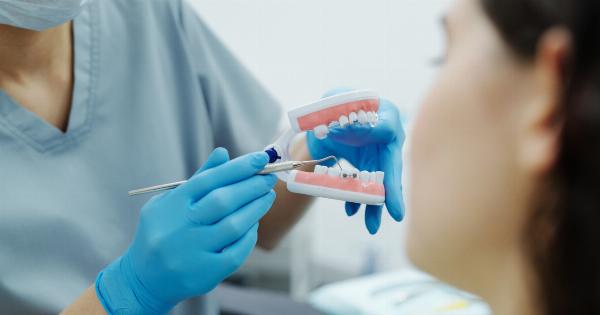Our teeth go through a lot every day, from biting and chewing food to enduring temperatures and grinding forces. While teeth are designed to be resilient, they can still sustain damage over time, leading to various dental problems.
Understanding the causes of tooth damage and the available repair options is crucial for maintaining optimal oral health. In this article, we will delve into the common causes of tooth damage and explore the different options to repair damaged teeth.
Causes of Tooth Damage
1. Dental Cavities:.
Cavities, also known as dental caries or tooth decay, are a prevalent cause of tooth damage. Bacteria in the mouth produce acids that attack the tooth enamel, leading to the formation of small holes or cavities.
Poor oral hygiene, frequent consumption of sugary and acidic foods, and inadequate fluoride exposure contribute to the development of cavities.
2. Tooth Fractures:.
Teeth can fracture due to various reasons, such as biting on hard objects, trauma, or accidents. Fractures can range from small cracks in the enamel to severe breaks that extend into the tooth’s root.
Fractured teeth are not only painful but can also affect chewing and cause sensitivity.
3. Enamel Erosion:.
Enamel erosion occurs when the tooth enamel gradually wears away due to excessive consumption of acidic foods and beverages, acid reflux disease, or vigorous brushing with a hard-bristled toothbrush.
As the enamel weakens, the underlying dentin becomes vulnerable to damage.
4. Gum Disease:.
Untreated gum disease, also known as periodontal disease, can cause tooth damage. As bacteria accumulate and multiply in the gums, they can gradually destroy the supporting tissues and bone surrounding the teeth.
This can lead to tooth loss and require extensive dental procedures to repair the damage.
5. Bruxism:.
Bruxism, or teeth grinding, is a common habit that often occurs during sleep. The excessive grinding and clenching exert significant pressure on the teeth, causing them to wear down, chip, or crack over time.
Bruxism can be the result of stress, misaligned teeth, or an abnormal bite.
6. Trauma:.
Accidents or injuries to the mouth can lead to severe tooth damage. Falls, sports-related impacts, or other traumatic events can cause teeth to fracture, dislodge, or even be completely knocked out.
Immediate dental care is crucial to increase the chances of successful repair.
Repair Options for Damaged Teeth
1. Fillings:.
For minor tooth decay or cavities, dental fillings are a common and effective repair option. The dentist will remove the decayed portion of the tooth and fill the space with a suitable material, such as composite resin, amalgam, or porcelain.
2. Crowns:.
When a tooth is severely damaged, a dental crown can restore its shape, strength, and appearance. Crowns are custom-made to fit over the existing tooth after any decay or fractures are removed.
They can be made from various materials, including porcelain, metal alloys, or a combination of both.
3. Veneers:.
Veneers are thin shells made of porcelain or composite resin that are bonded to the front surface of the teeth. They can effectively repair chipped, stained, or slightly crooked teeth, enhancing the overall appearance of the smile.
Minimal enamel removal is required before placing veneers.
4. Dental Bonding:.
Dental bonding involves applying a tooth-colored resin material to the damaged tooth and then shaping and polishing it to match the natural teeth.
This procedure is commonly used to repair minor chips, cracks, or gaps and can usually be done in a single visit to the dentist.
5. Root Canal Therapy:.
When tooth decay or trauma reaches the innermost layer of the tooth, known as the dental pulp, it can lead to severe pain and infection.
Root canal therapy involves removing the infected pulp, sterilizing the tooth’s interior, and sealing it to prevent further damage. A dental crown is often placed on the treated tooth for added protection and strength.
6. Dental Implants:.
If a tooth is severely damaged and cannot be saved, dental implants offer a permanent solution. An implant is a titanium post surgically placed into the jawbone, acting as an artificial tooth root.
A dental crown is then attached to the implant, providing a natural-looking and functioning replacement tooth.
7. Dentures and Bridges:.
When multiple teeth are missing or damaged, dentures or bridges can be used to restore functionality and aesthetics. Dentures are removable prosthetic teeth, while bridges are fixed restorations that bridge the gap created by missing teeth.
Both options offer viable solutions, depending on the extent of tooth damage.
8. Orthodontic Treatment:.
In cases where tooth damage is due to misalignment or bite issues, orthodontic treatment may be necessary.
Braces or clear aligners can gradually move the teeth into their proper positions, reducing the risk of further damage and improving overall oral health.
9. Dental Extractions:.
In some situations, tooth damage may be beyond repair, or removing the tooth is the best course of action. Dental extractions can help alleviate pain, prevent the spread of infection, or create room for orthodontic treatment.
After extraction, replacement options such as implants or dentures can be considered.
10. Continuous Dental Care and Maintenance:.
Prevention is always better than repair. To minimize the risk of tooth damage, it is essential to practice good oral hygiene, including regular brushing, flossing, and using fluoride toothpaste.
Routine dental check-ups and professional cleanings can also detect early signs of damage and prevent them from worsening.
Conclusion
Understanding the common causes of tooth damage and the available repair options is crucial for maintaining optimal oral health and a beautiful smile.
Whether it’s dental cavities, fractures, enamel erosion, gum disease, or other factors, seeking timely dental care and following preventive measures can help preserve the integrity of our teeth. Consult with a qualified dentist to determine the most suitable repair option for your individual case, and prioritize continuous dental care to keep your teeth in the best possible condition.























